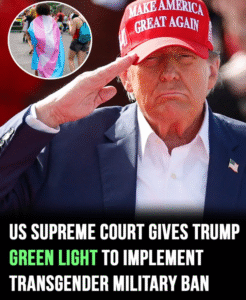US Supreme Court Greenlights Trump’s Military Transgender Ban: What It Means
In a significant and controversial decision, the United States Supreme Court has allowed the Trump administration’s ban on transgender individuals serving in the military to go into effect. The 5-4 ruling, issued in 2019, lifted nationwide injunctions that had previously blocked the ban, paving the way for the Department of Defense to enforce new restrictions on military service by transgender people. While the Court did not rule on the constitutionality of the ban itself, it allowed it to proceed while legal battles continued in lower courts.
The ban, first announced by then-President Donald Trump in a 2017 tweet, reverses a policy implemented under the Obama administration, which allowed transgender individuals to serve openly in the military. Trump’s order, later formalized by the Pentagon, restricts most transgender people from enlisting or continuing service unless they do so under their biological sex as listed at birth. Those who had already transitioned and were actively serving before the policy was implemented could be “grandfathered in,” but new recruits or those in transition face strict limitations.
Supporters of the ban, including the Trump administration and some military leaders, argued that allowing transgender individuals to serve would undermine military readiness and increase medical costs. They cited concerns over unit cohesion and deployability, especially when service members require gender transition procedures and recovery time. Critics, however, argue that the ban is discriminatory and rooted in bias rather than evidence. Major medical organizations, including the American Medical Association, have stated that there is no medically valid reason to exclude transgender people from military service.
LGBTQ advocacy groups have strongly condemned the Supreme Court’s decision. Organizations like the Human Rights Campaign and the American Civil Liberties Union called it a setback for civil rights and a betrayal of patriotic Americans who are willing to serve their country. Many see the policy as a dangerous precedent that could signal broader rollbacks of rights for LGBTQ individuals.
The political implications of the ruling were also significant. Coming at a time of deep polarization in the U.S., the decision highlighted how judicial appointments made by Trump—specifically Justices Neil Gorsuch and Brett Kavanaugh—shifted the ideological balance of the Court. Their votes proved decisive in allowing the ban to proceed.
While legal challenges to the policy continued in federal courts, the Supreme Court’s decision sent a strong message that the administration’s approach could stand—at least temporarily. For many transgender individuals in uniform, it cast a shadow over their future and raised serious questions about equality, fairness, and military service in America.
The policy was ultimately reversed by President Joe Biden on his first day in office in 2021, allowing transgender individuals to serve openly once again. However, the Supreme Court’s earlier decision remains a reminder of how executive power and judicial interpretation can dramatically shape civil rights policies. As of today, the issue continues to resonate in debates over inclusion, military policy, and the role of the courts in American democracy.
